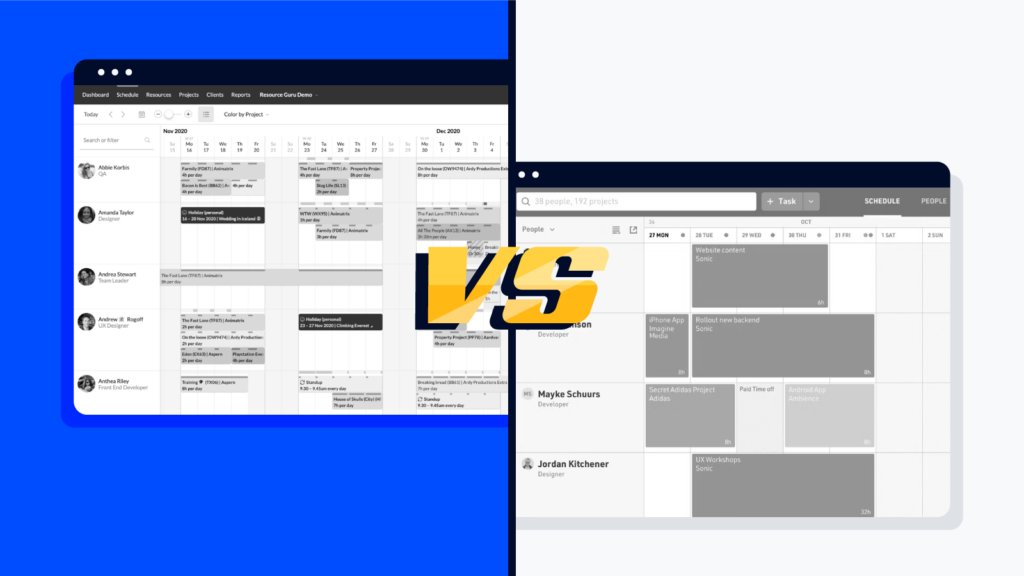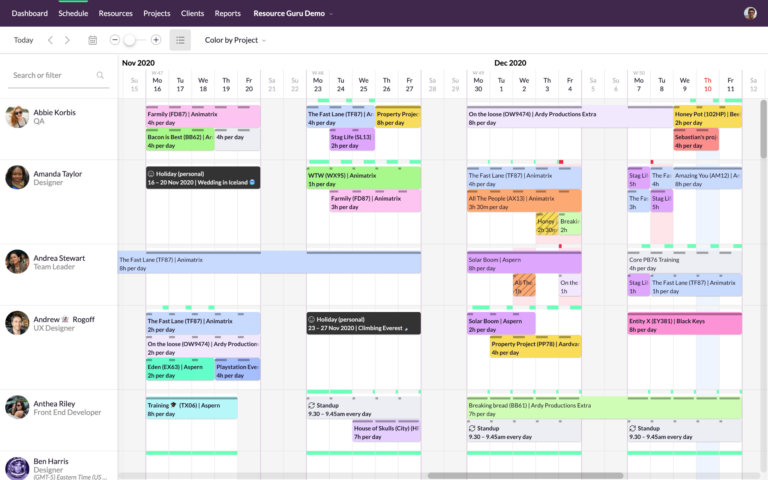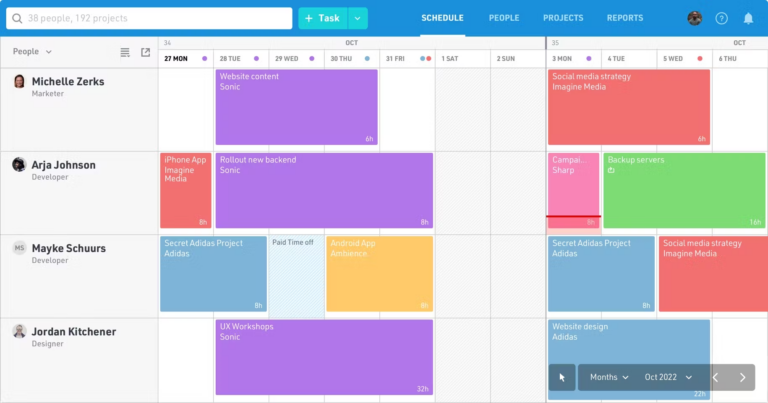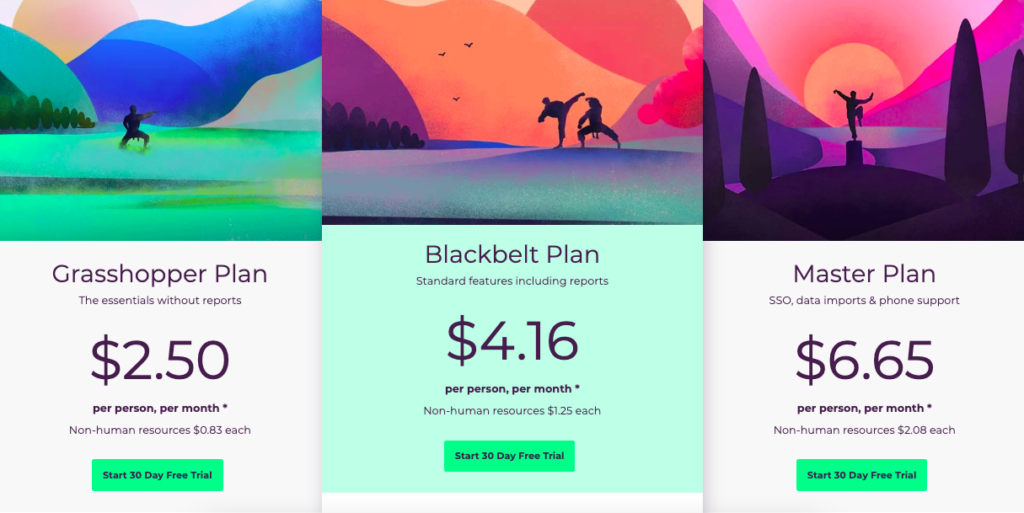Introduction
Resource Guru and Float are frequently compared to each other. And sure, they’re both popular cloud-based resource management tools. But if you’re looking for a way to decide which of these two platforms is right for your business, there are some key differences to be aware of.
In this article, we’ll show you the similarities and differences and outline some of the strongest use cases, so you have a better idea of how each platform works for businesses like yours. Our goal is to provide you with everything you need to know to make an informed decision between Resource Guru and Float.

Resource Guru vs. Float Outline
Everything you need to know to make an informed decision between Resource Guru and Float.
Expert Summary: Resource Guru vs. Float
Resource Guru and Float are both web-based resource management platforms. They give teams a clear overview of their resource capabilities, allowing them to plan and manage their capacity effectively.
Both programs have similar resource management features, including employee scheduling, project tracking, budgeting and forecasting, and capacity management. They also both have a drag-and-drop feature, making it easy for teams to customize the workflow and dashboard layouts and make quick changes to their resource schedule.
However, there are some key features that differ.
Float has more budget management capabilities than Resource Guru, whereas Resource Guru has more features for planning and managing logistics. Pricing also varies between the platforms, with Resource Guru coming out cheaper overall (I’ll go into the pricing in more detail later).
But first, let’s look at a side-by-side comparison of each platform.
Side by Side Comparison Of Resource Guru vs Float

Resource Guru is a simple resource management solution for teams that want to better wrangle their activity tracking and project scheduling. Using this software, project managers and team leaders will spend less time planning and tracking resources and more time focusing on critical tasks.
With its intuitive user interface and cost-effective pricing, Resource Guru would be best for smaller businesses. But don’t worry — even though the price point is low, it still has the key features you need for powerful resource management. You can manage tasks, track annual leave, and keep on top of your team’s capacity.
From $3/user/month
30-day free trial available

Float is a simple resource management software used to plan capacity and schedule work. You can create project timelines, manage capacity planning, and leverage task scheduling capabilities.
Compared to Resource Guru, Float’s budget and forecasting capabilities are more advanced. You can keep on top of budget tracking in real-time, create cost-to-completion estimations, and compare your estimates with actual spend. Because of its forecasting functionality, Float would be an ideal choice for teams looking to create precise forecasting estimates.
Resource Guru vs. Float Comparison Criteria
Here are the areas we reviewed when comparing Resource Guru and Float:
-
Feature list
What do you get, and what do you not get? -
Use cases
What are the most effective use cases for this feature set? -
Ease of use
Is it easy to learn and master? -
Integrations
Is it easy to connect with other tools? -
Customer support
Can you get help easily and quickly? -
Price
How appropriate is the price for the tool?
Differences Between Resource Guru vs Float
-
Pricing
Resource Guru is cheaper, with plans starting at $2.50/user/month. Float’s pricing starts at $6. -
Attendance management
Resource Guru allows users to manage attendance at work. As a result, you can reduce productivity losses and pick up any work that’s fallen behind. -
Event calendar and scheduling
Resource Guru also has a meeting room booking system. You can also track room usage. You can manage meeting room equipment, like projectors, screens, and other meeting devices.
-
Automated employee scheduling
Teams can automatically schedule work based on an employee's availability and skill. They can also quickly adjust to unexpected changes (such as a sick day). Resource Guru doesn't have this. -
Budget management
With Float, teams have access to cost estimating and cost-to-completion features, as well as other budget management capabilities. Resource Guru doesn't have the same level of budget management features. -
Deeply Customizable reports
With Float, you can set entire project budgets (based on time or cost), compare scheduled time with actual hours spent, and review billable and non-billable hours alongside one another.
-
Drag and drop
Both platforms have an incredibly useful drag-and-drop feature within their interface. As the name suggests, this means you can simply click an item in your schedule, move it to where you want it to be, and drop it. It makes it easy for team leaders and managers to quickly make changes to the schedule. -
Forecasting capabilities
Resource Guru and Float both have forecasting features that allow users to predict future goals, metrics, and milestones. These also help you with efficient resource planning, making sure that you’re allocating resources effectively to keep projects on track. -
Leave management
Track employee vacation days with leave management features from both platforms. This feature gives you a clear picture of your team’s absence in the context of your current workload, allowing you to schedule work based on capacity and resource availability. -
Real-time updates
Because the platforms are both online, they provide real-time insights. You can easily log in to the software and see the most up-to-date information about your resource schedule — and the same goes for your team. As long as you have an internet connection, you’ll be able to see your real-time resource scheduling. This also helps boost team collaboration, particularly if you’re working with remote teams. Everyone can access the same information at the same time, streamlining the collaboration process and making it easier for distributed teams to work together. -
Dashboard
Both platforms provide a dashboard to display key information and metrics about your resource scheduling. With one glance, you can see how the most important elements of your resource management are performing. -
Campaign management capabilities
Schedule and plan all the elements of an upcoming campaign with both Resource Guru and Float. Use the calendar to time-block your work, focus on task management, and keep up to date with progress in real-time. -
Client management capabilities
Track and manage your client relationships with Float and Resource Guru. Both platforms can help you manage client relationships. You can schedule client projects, share client reports, and allocate resources efficiently to deliver client work. In Resource Guru, you can also group projects by client, making it easier to see what's in the works for each client. -
Integrations
Both platforms allow you to integrate with third-party tools to streamline your resource management and expand your capabilities. Resource Guru integrates with Zapier, an online third-party platform that automates workflows by connecting platforms such as Facebook, Google Drive, and SurveyMonkey (take a look at the full list). Float integrates directly with a lot of platforms, including Asana, Slack, and Quickbooks (Float also integrates with Zapier). -
Mobile access
Access Float and Resource Guru on the go with their mobile apps. The layout is slightly different from the web versions but still user-friendly. Any changes made in the app are also reflected on the web versions, so everything updates all at once -
Performance metrics
See how your entire team is performing by tracking performance metrics on both platforms. You can identify how long people take to complete their work, whether they’re on schedule to hit a deadline, and how the team is performing. You can also measure your business performance to see if you’re on track to reach your goals. -
Project management/project planning capabilities
Although not technically project management tools, Resource Guru and Float certainly have the features of project management software. You can use task management, create project timelines, and keep on top of project progress in real-time.
Best Use Cases for Resource Guru vs Float
-
Project Management
Use Resource Guru task management and timelines for a simple project management solution. -
Remote Work
Use Resource Guru to organize a remote workforce with attendance management and scheduling features. -
Facility Management
Leverage management and booking capabilities, whether you’re scheduling A/V equipment, IT gear, room space, tools or anything else. -
HR Planning
Get a clearer picture of the road ahead with daily time off emails and a staff holiday planner–whether it's vacations, sick time, paternal leave, or some other kind of absence. -
Startups & SMBs
An affordable pricing schema makes Resource Guru an appropriate choice for startups, freelancers, and small businesses.
-
Project Management
Use Float task management and timelines for a simple project management solution. -
Remote Work
Float boasts features for remote collaboration and teamwork such as socially engaging messaging systems and a built-in inbox. -
Financial Management
Use Float for cost estimating and cost-to-completion features, as well as other budget management. -
Sales Teams
Use Float to build customized sales-oriented dashboards that track financials, goals, and initiatives. -
Nonprofit Organizations
Float offers discounted pricing for 501(c)(3) nonprofit organizations.
Resource Guru vs Float Pricing Comparison
This side-by-side price comparison shows Resource Guru’s price compared to Float. Let’s start by looking at Resource Guru.
Resource Guru Pricing
ResourceGuru’s resource management software has three separate pricing models: Grasshopper, Blackbelt, and Master. All of these plans offer unlimited projects and clients. If you want detailed reports, you’ll need to sign up for the Blackbelt or Master plan.

Payments can be made on an annual or monthly basis. If you opt for the annual payment plan, you’ll get two months free.
Float Pricing
Similar to Resource Guru, Float has three pricing options: Resource Planning, Resource Planning + Time Tracking, and the Plus Pack.

All of Float’s pricing plans include 24/7 support, a reliable security protocol, and data protection.
Both platforms charge based on the number of people who use the platform and are part of the resource schedule. This means that you only pay for the number of people you want to use the platform. With Float, you can also have guests on the platform for free.
Conclusion
Resource Guru and Float offer similar resource management features and capabilities. Choosing the right one for your business comes down to what you want to get out of your resource management software.
If you’re looking for a resource planning tool with more financial capabilities to manage budgets and forecast future spending, Float is your best bet. If you want resource allocation software that’s cost-effective with a simple interface, Resource Guru could be the right choice.
What do you think? Do you have any feedback from using either one of these platforms? Let us know in the comments.


